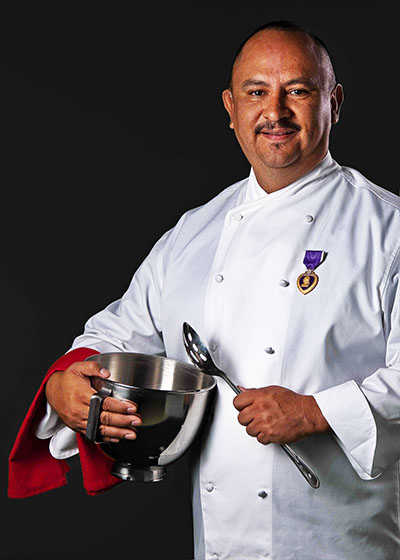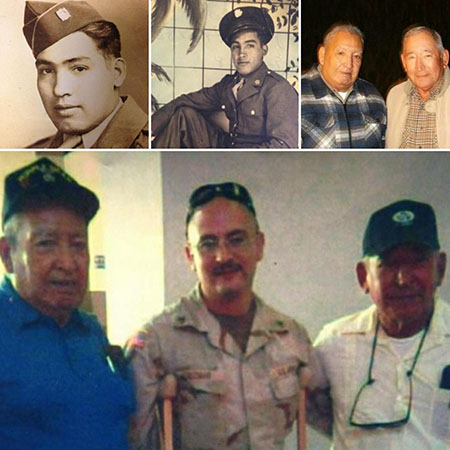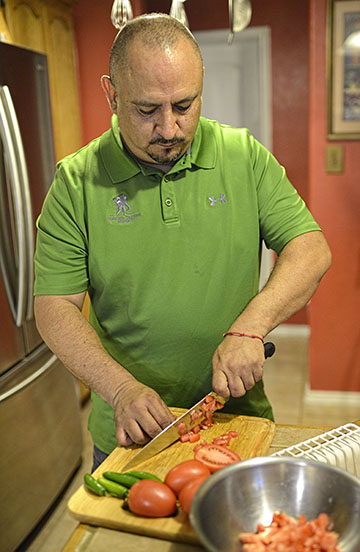Purple Heart Recipient Finds Healing through Culinary Arts

Wounded Warrior Project® (WWP) helps veterans who left pieces of themselves on the battlefield find healing from visible and invisible wounds. Many of these servicemen and women received a recognition they did not seek: a Purple Heart award.
David Guzman is one of those veterans. He has a long family history of military service and, for better or worse, a long history with the Purple Heart.
His uncle, Francisco Guzman, a World War II veteran, earned a Purple Heart for his service in France. David only knew that his uncle had a disability of mysterious origin. After David was injured, his uncle let him in on the story.
“The day I got home from Iraq, a month after my injury, my uncle was there at the airport along with other relatives,” David recalled. “He just leaned over and whispered in my ear, ‘You’ve become a blood brother whether you like it or not. Wear it with pride.’”
A year later, Francisco visited David, and they talked until 4 a.m. Francisco related the trials he lived through in France during the last days of WWII. How he survived the fighting and the cold during the Battle of the Bulge, how people from the countryside helped him recover and walk again, and how the experience haunted him.
“My uncle seemed to have tunnel vision as he told me his story,” David said. “We were sitting in my backyard, but he brought me there – I felt like I went to France with him.”
“My uncle walked me through the steps of this unique brotherhood of Purple Heart recipients,” David said. “I was always pushing to be in the military because I looked up to my dad, who served in the Air Force, my uncle, and my older siblings.”
Heritage That Hurts
David was born in Utah and raised in Texas. After high school, he went to technical school and learned about trucks and engine repair, so he felt comfortable working as a truck driver when he joined the Army in 1989.

David rose through the ranks to become a sergeant and had several duty stations. He was deployed to Iraq in 2004 at age 38. He had been in the country for four months when he was wounded in September 2004.
Normally, David would lead a truck convoy that traveled at night. But this time, he was assigned to a daytime trip out of Camp Taji, north of Baghdad.
At the time, the 5-ton trucks used by Army personnel did not always have armor, but this vehicle had a steel plate welded to the bed of the truck – and open windows.
David was in the front passenger side, and he remembers passing a small white truck – from which someone detonated multiple improvised explosive devices under, and around, his U.S. Army vehicle. David blacked out and was pulled out by unit members.
“The shrapnel from the blasts went through my door and through me,” David said. A shrapnel fragment went through David’s face, knocked out a molar, and pierced his tongue. The gunner in the back also suffered facial wounds from shrapnel. David believes they survived because of the steel plate welded to the bottom of the truck.
The explosion was on a Friday, and David woke up on a Sunday. He remembers the pain, the dirt in his eyes and ears, a gauze in his mouth, and stitches on his tongue and face. In addition to the shrapnel that tore through his face and mouth, he had a ruptured eardrum, and rods in his wrist and right leg. A larger shrapnel piece went in and out of his leg, severely damaging his calf muscle and tendons.
After five days in Baghdad, David expected to be medically evacuated, but that didn’t happen. He was sent back to his unit despite his injuries. It would be another 25 days before a doctor saw him and prompted his command to get him evacuated.
This delay was detrimental to his physical health and deeply affected his mental health. He was finally sent home on a regular flight, with his swollen leg. He could tell his leg wounds were infected.
He was sent to Texas first, where he received medical attention in the ICU at Brooke Army Medical Center in San Antonio. The swelling turned out to be gangrene. He lost his Achilles tendon because of the lack of treatment and his right foot dropped. Long-term treatment of the infected leg saved the limb, although doctors discussed amputation at one point.
David continued to recover and received physical therapy and speech therapy while still on active duty. He was reassigned to a motor pool at Fort Lewis, Washington, but he felt isolated in his new unit and knew he needed to reach out for help. He connected to WWP for psychological support and connection to other veterans.
In April 2005, David received a Purple Heart award. He asked the sergeant who held his IV the day he was injured and who later helped him get connected to the right resources to pin the medal on him. Although he barely remembered the details of that fateful day in September 2004, he remembered her kindness.
David separated from the military in October 2005 and had trouble finding a new mission in the civilian world. He still managed PTSD and would sometimes be up at 3 a.m. doing a “perimeter check” while his family slept.
Looking for purpose, he attended WWP events and enrolled in school again to complete the degree he always wanted. He felt fortunate to have lived to see his wife and children again. He wanted to make the most of his time despite any physical or emotional pain.
Healing Through Sharing Stories and Food
David went on to complete three college degrees, including a bachelor’s in Agricultural Science. He also earned three chef certificates from the Culinary Institute of America through WWP.

Going back to school as an older student with visible injuries, he recalls he would “walk in with my backpack and my cane.”
He received an unexpected lesson in humbly sharing his experiences in an English class.
His English teacher challenged him to write from his heart. He accepted the challenge and wrote a moving paper that ended with, “I will strive to complete my bachelor’s degree with great expectations, for love of my country, my family, and myself: a first-generation college student, a combat-wounded veteran, and, most of all, an American.”
Since then, David has continued to tell his story through speaking to veteran groups, WWP events, and through the art of cooking. Sharing stories over a good meal is something he says he absorbed by virtue of growing up in a Mexican American family.
“My mom and dad always cooked,” David recalled. “My dad was a cook in the Air Force.”
David received an invitation from WWP to attend a week-long training in San Antonio and New York at the Culinary Institute of America.
Sharing nourishing foods through volunteer cooking, David has traveled to Denver with a Purple Heart organization and cooked locally in the Austin-San Antonio areas for veterans at VFW chapters. He also volunteers at Veterans Day events. He once went to Montana to cook for a group that included actor and comedian George Lopez, who requested enchiladas.
“Food brings everyone together,” David said. “I would like to make it a better experience. You plate it and make it look nice and they eat with their eyes. People open up, and you gain trust through simple conversations. I call these ‘magic moments:’ when I can help bring out the best in people and help other veterans forget the nightmares.”
“I’ve been blessed with Wounded Warrior Project connecting me and facilitating the cooking classes and the opportunity to use those skills,” David said.
Receiving a Purple Heart and being able to give back through volunteerism has “opened a lot of doors – it has been a humbling experience,” David said.
David feels motivated to talk with other veterans about going back to college. “Even if you don’t think you need a degree, or letters after your name, when you walk across the stage with your diploma, no one will ever take that away from you,” David said. He adds that nothing compared to the feeling of seeing his mom standing with his mentoring chef at graduation.
Giving Back Turns Pain into Joy
“More than anything else, receiving a Purple Heart means everything to me,” David said. He remembers his uncle’s words to “wear it with pride.” And at the same time, he challenges himself with “what have you done with it, and what legacy do you want to leave?”
These days David is thankful for every single day. He considers himself a survivor twice, having come back from war in Iraq and a recent bout with kidney cancer.
Life has taught David that “you only need two ingredients: love and passion, y ya con eso tienes.” And that is all you need, indeed.
This Purple Heart recipient is cherishing second chances and keeping busy helping other veterans.
Through WWP’s emotional support programs, adventure-based workshops, clinical care, and connection opportunities, warriors and their families can build resilience to overcome physical and mental health challenges.
| Why Do Service Members Get Purple Hearts |
|
The purple color in a Purple Heart award symbolizes the courage of warriors who were injured or killed in combat or by an act of terrorism. It is the earliest award in the U.S. military, first given by George Washington to soldiers in the Continental Army who shed blood for their new country during the Revolutionary War. It was then called the Badge of Military Merit and it consisted of a heart-shaped purple silk cloth. The original award lapsed, and the Book of Merit containing the names of early awardees was lost. However, the honor was not forgotten. In 1932, the U.S. War Department created the Order of the Purple Heart, establishing a registry and a process for awarding the honor. The award was gradually extended to military branches other than the U.S. Army and included all military branches by 1962. See a timeline here. Criteria for the Purple Heart now includes warriors injured in domestic terrorism acts, friendly fire incidents, and peacekeeping missions. In 2011, a standard was created for evaluating warriors injured by non-penetrating wounds (TBI). About 1.8 million Purple Hearts have been awarded. |
| WWP asked some of the warriors it serves what having a Purple Heart means to them. Here are their responses: |
|
|
|
Contact: Raquel Rivas – Public Relations, rrivas@woundedwarriorproject.org, 904.426.9783
About Wounded Warrior Project
Since 2003, Wounded Warrior Project® (WWP) has been meeting the growing needs of warriors, their families, and caregivers — helping them achieve their highest ambition. Learn more.